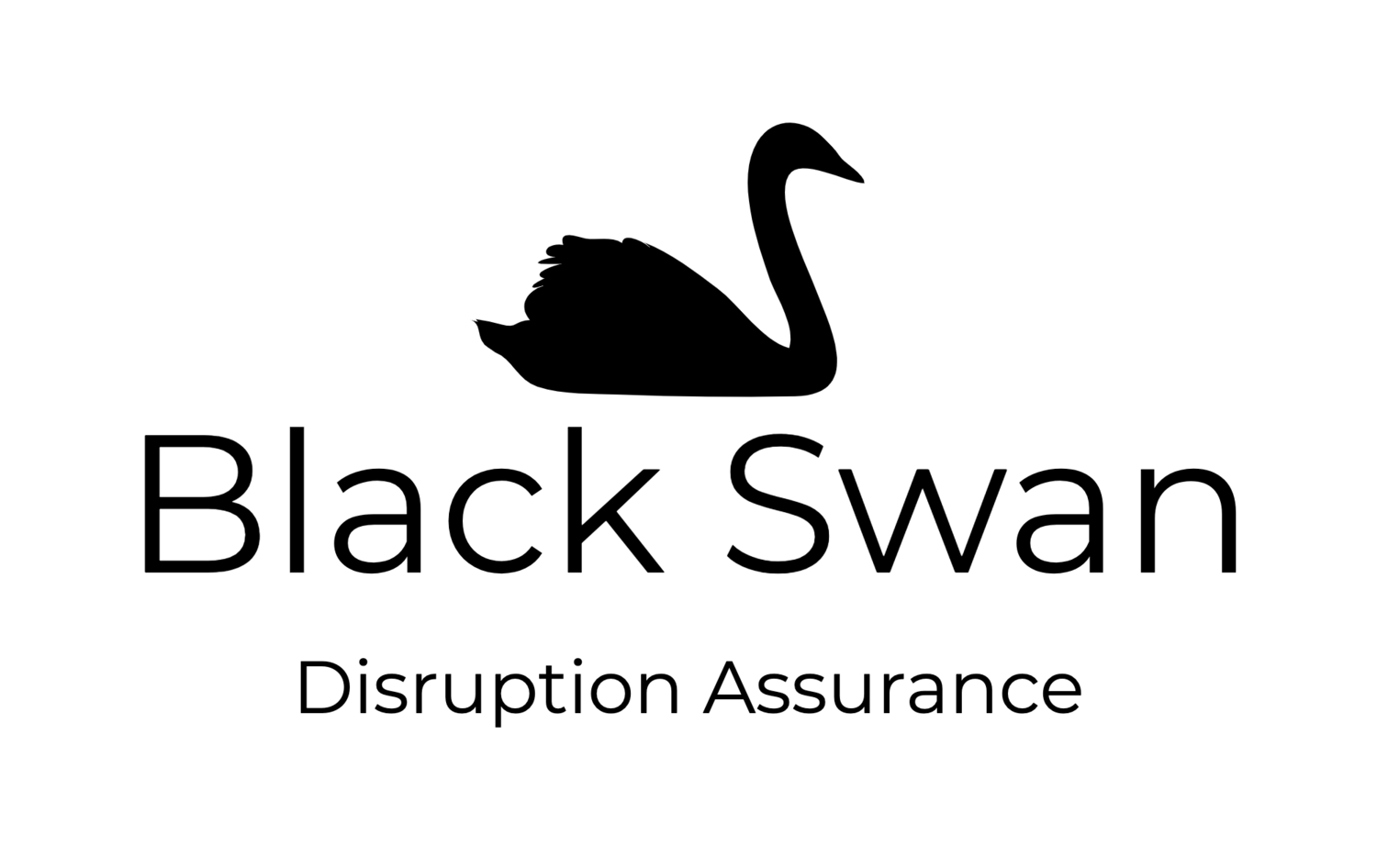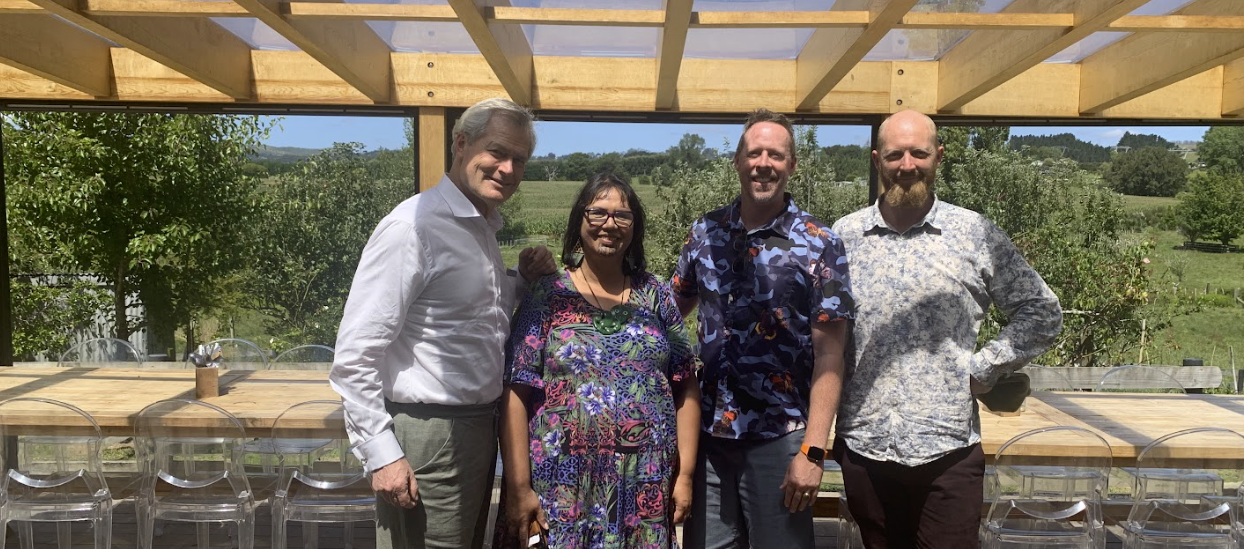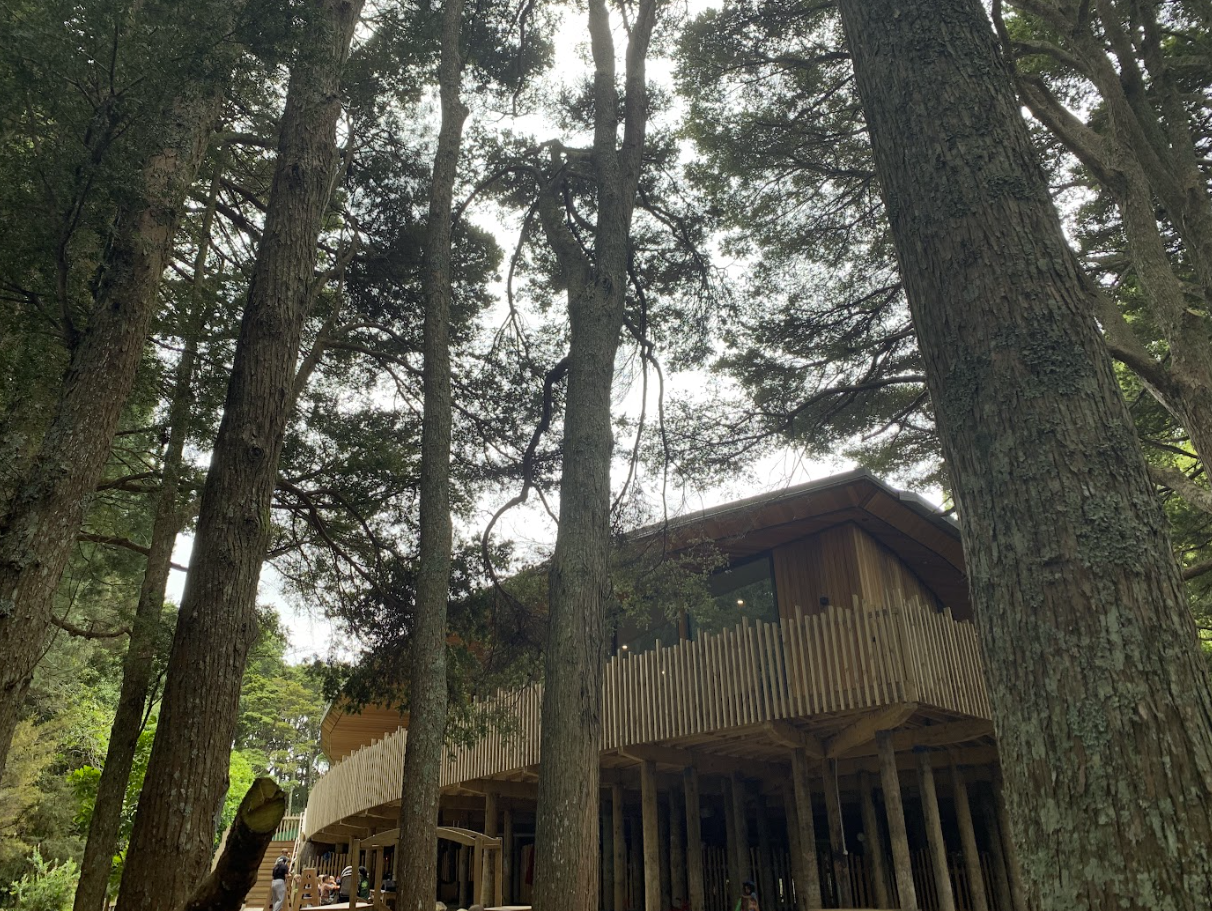A Day with Gunter Pauli
Lessons on Nature, Imagination and the Magic of Storytelling
From left to right, Gunter, Rangimarie, Myself and Bailey at The Farmhouse overlooking the Clevedon countryside
Edmund Hillary Fellowship's Role in Fostering Sustainability and Innovation
In sustainability and innovation, a few days can be as enriching as with Gunter Pauli, the visionary behind the Blue Economy, who works with 3,000 scientists at Zeri (Zero Emissions Research and Initiatives). Our day with Gunter, facilitated by the blessings of the Edmund Hillary Fellows, unfolded as a testament to the power of collaboration and vision in sustainability and innovation. Thanks to the efforts of Todd Porter and Joanne McEachen, a quick planned stop-over visit ensured that every moment was an opportunity for learning and connection with Rangimarie Parata Takurua and Bailey Peryman, who flew up from Otatahi, Christchurch.
The schedule took us to the GAIA (Earth) Forest Preschool for a site visit, where conversations with Dr Darius Singh bridged the gap between education and environmental stewardship. This visit highlighted innovative approaches to early childhood education, deeply rooted in sustainability and connection to the Earth.
Dr Darius Singh shares his vision for Gaia, with Rangimarie who runs Te Pa.
The Enchantment of Learning from Nature
Our journey began in the crescent-shaped embrace of nature, under the vast, native forest where the concept of learning from nature, as opposed to about nature, unfolded. Gunter, with his insightful narratives, introduced us to the marvels of biomimicry in our first discussions, causally asking if we had read the book Biomicry by his friend Janine Benyus demonstrating how the intricate designs and systems found in the natural world, from the efficient form a whale’s energy system to the nutrient-recycling wisdom of the Amazon rainforest, offer blueprints for sustainable innovation.
Permaculture and the Unseen Science
As we delved more deeply, the conversation flowed to the principles of permaculture—a science that mimics nature's no-waste, self-sustaining ecosystems. Like a tale from ancient lore, this segment revealed the secret of the Amazon's fertility, not requiring human-made fertilisers, challenging us to rethink how we cultivate our food and manage our lands.
The Tale of a Modern-Day Pirate and the Quest for Sustainability
Amidst tales of biotech waste and low-cost sanitation solutions, Gunter's narrative turned whimsical, likening his endeavours as he shared being a modern-day pirate. He shared stories of how he had to remove Porrima, his boat, demonstrating that this renewable energy could make it sail through the oceans with total autonomy. However, when sailing under a flag, Gunter becoming a pirate was one of those founder stories, a treasure of sustainability, battling against the seas of pollution and the storms of those enforcing the environmental degradation models without kindness or forethought. Ironically, I’ve been called a pirate in a past venture that caused media convergence in New Zealand. He spoke of hospital boats and zero-fuel initiatives, painting a vivid picture of innovation that left no mark on the natural world—except for the positive change it spurred to enable zero-fuel cost hospital bosts to the 11,000-16,000 islands inhabited but without access to medical care.
Porrima has joins forces with an investment consortium to create a sustainable maritime industry.
The Whispers of the Forest: Women, Leadership, and Legacy
As our conversation wandered into one of the four remaining natural forests in Auckland, he shared the stories of Oman and China, where STEM is taught through stories, as we stood under forest custodians, sharing that emotional intelligence is essential for education for China, to lead the charge towards global sustainability and rural resurgence as he discussed how they are bringing down the highrise structures and restoring rural communities to prevent climate change.
This part of our discussion felt like stepping into a fairytale, enriched with a conversation with a four-year-old real-life princess who cautioned us about bears and offered guidance for our journey. This whimsical moment transitioned into Gunter's interactions with princes on the crucial topic of environmental stewardship. He shared insights on Sheikh Zayed's commitment to fostering female leadership through the Zayed Sustainability Prize. His initiative aims to prepare women for leadership roles in the UAE and Oman, challenging and broadening my preconceived notions about the region's approach to oil production, nature conservation, and human rights.
Gaia (Earth) Forest Preschool New Zealand. The World's first childcare centre fully inspired by the "Gaia (Earth)
We spent time in a realm where magical themes intertwine with a discussion about teaching kids about energy by imagining the whale pumping 1,000 litres every pulse through a hundred million veins and arteries or how the Yoyo and a kite can inspire clean energy. The sail is western; the kite is within us. We all play with them as kids. The Yoyo is a toy known across cultures everywhere and embodies the essence of action and reaction, a fundamental principle of physics. Its operation relies on a user's ability to make quick, intuitive decisions—often within a fraction of a second (1/10 second, as he noted)—to maintain its motion. The connection between playing with a yoyo and making environmental decisions underscores the potential to harness our innate abilities for broader, more critical nature-based inspiration, such as how our technology inspired by a mimicking a cow's digestive system to increase energy to provide sustainable low-energy sewerage treatment as 80% of the worlds sewerage discharged into the ocean.
Similarly, the kite, relying on wind for flight, symbolises the harmony between human creations and natural forces. Unlike windmills, which also harness wind but are static and mechanically complex, kites are simple, flexible, and mobile, embodying the potential for sustainable solutions that work in tandem with nature rather than attempting to dominate it. The kite's flight is a dance with the wind, a partnership that requires understanding, adaptation, and respect for natural forces—qualities essential for sustainable living, proving to be a practical solution for Palau provided by the SkySails power system.
Humpback whale's heart has 'nano' wires to circulate energy that could help treat heart disease.
Perhaps the most profound revelation was the untapped potential for significant environmental projects, the awakening of sleeping giants like China to the urgency of climate change, and the clear pathway to decarbonising industries by prioritising emotional intelligence in children's education for the past 15 years. He shared insights into how these could be achieved not by the legacy behemoths of our industrial past but by nimble, innovative minds ready to rewrite the rules. Now imagine the whale, pumping 1,000 litres every pulse through a hundred million veins and arteries, the system's efficiency, and how that inspired whales; the whale has a design within its heart that could help save the lives of many patients suffering from heart disease. With a heart that can pump six bathtubs of blood around a circulation system that is 4,500 times as complex as our own and in only three heartbeats a minute, it has fascinated scientists as to how it manages this feat, which is the key to educating our tamariki (kids). It held and I have a whale tattooed on my back from a kundalini awakening while I was with the orca in Tonga.
Zeri for kids inspires storytelling from nature; I, too, have a whale fluke tattooed on my back, which showed Bailey on our walk.
Local Economy and Dual Currency System
The concept of a local economy thriving on a dual currency system, particularly in communities of no more than 15,000 people, presents a powerful model for sustainable economic development. This system can effectively double the local monetary velocity, ensuring that money circulates within the community, strengthening local businesses, reducing unemployment, and fostering a stronger sense of community. For Māori iwi (tribes) in New Zealand, adopting such a model could enhance economic sovereignty and resilience, supporting initiatives that align with Māori values of kaitiakitanga (guardianship and conservation) and whanaungatanga (kinship and community).
Nature as Accumulating Capital
Viewing nature as a capital accumulating value marks a significant paradigm shift from conventional economic models, which often regard natural resources as expendable commodities. This innovative perspective acknowledges nature's regenerative capacities as a foundational capital that appreciates over time. Consider the analogy of a fruit tree: the fruit it bears can be seen as the immediate yield or income, like in Steven Moe's new book, while its seeds represent the promise of future growth and abundance. From this viewpoint, sustainable practices are not merely efforts to conserve but investments in the natural capital destined to bring returns for future generations.
This paradigm shift resonated deeply with me, mirroring the ethos we embrace at Alimentary Systems, where nature is a beneficiary and a stakeholder, akin to Novamont's approach that prioritises the efficient use of resources and fosters territorial regeneration. By establishing biorefineries that produce bioplastics and bioproducts from renewable sources, Novamont aims to safeguard soil and water, starting from local areas. Our aim is parallel as we strive to manage organic waste with a vision for zero waste, a positive water footprint, and a beneficial impact on soil.
Gunter shared a compelling anecdote about facing legal challenges from the local authorities for not connecting to the municipal wastewater system despite having a zero-impact waste solution. I faced similar issues when I launched an online medical business accused of using off-shore Doctors - that was untrue. This story highlighted a critical issue: sometimes, the challenge is not about the technology or intent but about navigating existing regulatory frameworks that inadvertently perpetuate the status quo. His experience underlines the complexities of introducing innovative solutions outside conventional parameters. The acquisition of Novamont by Versalis, valuing the bioplastic maker at approximately 1 billion euros, serves as a beacon, confirming that Alimentary is on the right track towards forging a sustainable future for our children.
This narrative underscores the importance of reimagining our relationship with nature and highlights the systemic challenges innovators face when disrupting traditional models. It's a powerful reminder that creating a sustainable world for our tamariki (children) requires both visionary thinking and resilience to navigate the intricacies of existing systems.
Conclusion: A Fairytale of Tomorrow
As the day waned, the stories and discussions with Gunter blended into a narrative that was both was as much a fairytale and a stark reality that gave me hope that our manifesto for change has a blueprint for a sustainable future that respects and learns from the wisdom of the natural world and leaves no trace.






